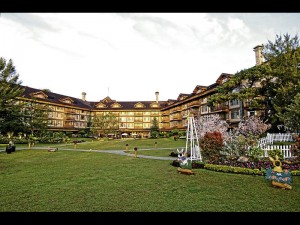CAMP JOHN Hay’s history had undergone a colorful, storied—and sometimes traumatic path—for 80 years. It served as a rest and recreation base for the American soldiers and a concentration camp for the Japanese nationals. During the World War II it was reduced to ruins. Decades and many presidents later, the sprawling property has come to be known a scenic mountain resort and home to the world-class The Manor Hotel in Baguio City.
Built in 2000, the hotel structure has drawn unparalleled attention with its impressive structure taking concept from forest log cabins set amid a backdrop of towering pine trees. Its interiors evoke a Filipino-Colonial feel with paneled walls, wooden furniture and outdoor patios.
But this four-story structure is not just swank and swagger. Behind the imposing Manor Hotel and its cozy interiors are green warriors who take conscious efforts in making the hotel a model of green structures in the city.
Innovations
“Throughout its operations, the hotel has come up with many innovations to support the green movement,” said Ramon Cabrera, general manager in an exclusive interview with Inquirer Property.
The most significant energy efficiency measure at present is the hotel’s lack of air-conditioning units owing to an already favorable weather and temperature in the city. All lighting fixtures in the hotel were likewise replaced by compact fluorescent lamps from the old halogen and incandescent lamps.
As per report of its engineering department, as of May 2011 the company was able to save 112,320KW or 16.05 percent compared to last year’s energy consumption. The energy savings were due to the bulb replacements, it reported.
The Manor Hotel offers guests with 177 rooms on five-star services through highly trained staff and its world-class facilities. Guests can choose from studio-type, one-bedroom and two-bedroom units, all offering a breathtaking view of the mountain range and pine forests. All units are equipped with a refrigerator, hot and cold shower, in-room safe and a phone system.
THE IMPRESSIVE structure takes concept from forest log cabins set amid a backdrop of towering pine trees.
Energy cards to activate electrical power inside the rooms are also implemented inside the hotel premises.
Blessed with an environment that truly sets it apart from other hotels in the city, it doesn’t come as a surprise that the hotel makes a conscious regard of its environs.
For its landscape improvement, Cabrera said the hotel uses compost for fertilizers. The wood materials used for furnishings are made of cedar logs imported from Canada and have undergone wood treatment prior to its importation.
From the recent data provided by CJH Development Corp., there are approximately 250,000 full-grown trees in the area. The Manor occupies 2.48 hectares of land.
Cabrera furthered that companies within the CJH complex conduct annual tree-planting drive to replace rotten or uprooted trees due to natural calamities. If there are trees threatened during expansion purposes, it seeks permission from the local environment office. The hotel follows the principle of replacing 100 pine seedlings for every tree cut.
Breathtaking rooms
Aside from the magnificent view of the Cordillera mountain range and the breathtaking rooms, The Manor Hotel at Camp John Hay has a lot more to offer. It has a bar and restaurant owned by the famous chef Billy King, a top-of-the line gym and a spa. Outside, guests can visit places within the camp such as Shalan ni Kabadjo, Ecotrail, The Historical Core, Butterfly Sanctuary, The Art Park and Igorot Garden.
For the more adventurous, the Paintball Republic and the Baguio Tree Top Adventure are must-try. The complex also houses a Jack Nicklaus-designed 18-hole golf course.
Currently the hotel averages 70 percent to 80 percent occupancy rate during peak or off-peak period. It is managed by Camp John Hay Leisure Inc., which also runs The Suites at Camp John Hay and CAP-John Hay Trade and Cultural Center.
